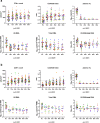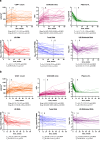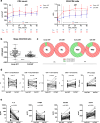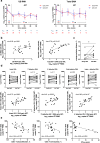Long-term effect of temporary ART initiated during primary HIV-1 infection on viral persistence
- PMID: 40738892
- PMCID: PMC12311192
- DOI: 10.1038/s41467-025-62362-0
Long-term effect of temporary ART initiated during primary HIV-1 infection on viral persistence
Abstract
Initiation of antiretroviral therapy (ART) during primary HIV-1 infection (PHI) has been proposed to limit the formation of HIV-1 reservoirs. However, it remains unknown whether temporary ART initiated during PHI has a long-term effect on viral persistence. Here, we longitudinally quantify HIV-1 persistence markers and immunological parameters in the participants (n = 64) of a randomized controlled trial comparing 24 or 60 weeks of temporary ART vs. no treatment during PHI, who subsequently (re)initiated ART during chronic HIV-1 infection (CHI) after a median period of 116 weeks without treatment (ISRCTN59497461). Levels of several HIV-1 persistence markers (cell-associated unspliced RNA, total DNA, and intact DNA) do not significantly differ and strongly positively correlate between early and CHI ART periods in the same participants. Early ART is associated with lower HIV-1 proviral sequence diversity and superior restoration of the CD4/CD8 ratio, as well as lower levels of monocyte activation markers, compared to CHI ART, in the same participants. At CHI ART, intact HIV-1 DNA negatively correlates with HIV-specific T-cell responses. Finally, levels of HIV-1 persistence markers during CHI ART are lower in participants who had been pre-treated during PHI, indicating a long-term suppressive effect of temporary early ART on the persistence of HIV-1 reservoir.
© 2025. The Author(s).
Conflict of interest statement
Competing interests: The authors declare the following competing interests. F.W.W. has served on the advisory board of ViiV Healthcare, paid to his institution. The other authors declare no competing interests.
Figures







References
Publication types
MeSH terms
Substances
Grants and funding
LinkOut - more resources
Full Text Sources
Medical
Research Materials

